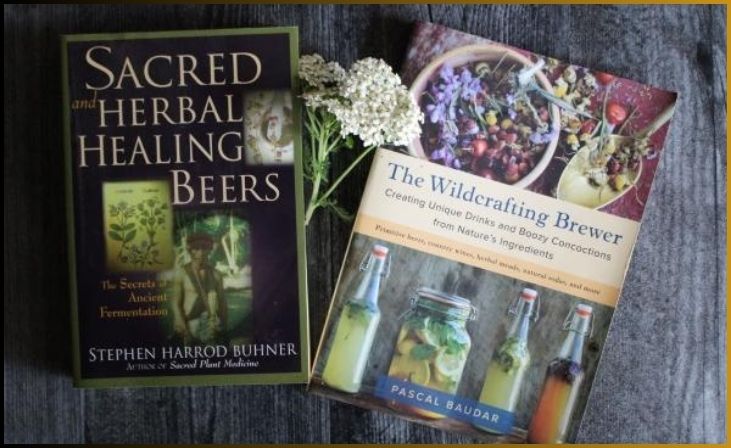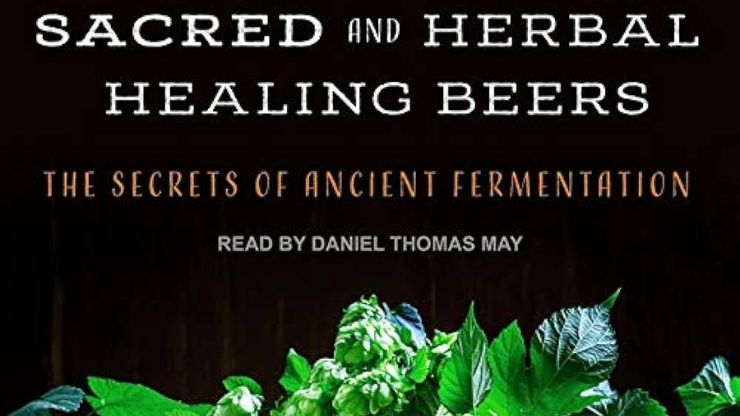Review of Sacred and Herbal Healing Beers, the Secrets of Ancient Fermentation, by Stephen Harrod Buhner. (Siris Books: Boulder, CO) 1998.
Fermentation is an ancient art. People have been doing it for millennia. It makes sense then that it is surrounded by mystery as well as history. The history of mead, ale, and beer making is a story of ethos, medicine, religion, and politics. It spans the full range of human culture and demonstrates the regulatory reach of government and church. Sacred and Herbal Healing Beers is a history, a materia medical, and a cookbook, written by one of the most respected names in the herbal medicine community.
The history of fermented brews is fascinating by itself. Initially, beer and ale were quite different than the drinks they are today. Brewed with herbs like yarrow, bog myrtle, and rosemary, ancient beer was stimulating, euphoric, and aphrodisiac. The brewing was controlled by the powerful Catholic Church. Brewers paid hefty royalties for the privilege of using the herbs, grown exclusively in monastery gardens. With the Protestant Reformation came a reformation in brewing, as well. Hopped beers became regulation brews, which put the drinker to sleep and suppressed sexual desire.
Table of Contents
ToggleA Quick Review About Sacred and Herbal Healing Beers

With the resurgence of craft brewing, Sacred and Herbal Healing Beers offers a foundation for home fermentation. The book begins with the history of beer, ale, and mead-making, drawing on ancient recipes, myths, and poetry. While today we understand fermentation to be a natural process, in the past it was steeped in magic, believed to be a gift of the gods to help mankind deal with mortality.
Buhner recounts a great many historical recipes for beer and ale, based on commonly available herbs like juniper berries, licorice, wintergreen, ginger, pine, birch, and other herbs. The recipes are adapted with modern measures so that the brew can be recreated in five-gallon batches for beer and one-gallon batches for mead.
Each herb used in the recipes has a brief materia medica so that you can see if those specific herbal actions are what you are looking for. The reader is helped to choose recipes that will improve their health and well-being. For instance, Maude Grieve’s Nettle Beer from 1931, includes nettles, dandelions, cleavers, ginger, brown sugar, and yeast. It was made as a remedy for gout and arthritic pains.
Quick Review: Book Review Big Book of Kombucha
Don't just scroll, subscribe!
BuzzTrail's unique web-stories are the cure for boredom you've been waiting for.
Traditionally herbal fermented brews contain a much larger amount of herbs than herbal teas. Maude Grieves’s recipe calls for a gallon of nettles, along with four handfuls of dandelion and cleavers. On the other hand, herbal tea bags contain less than a teaspoon of herbs. Herbal beer is tremendously strengthening and tonic, especially beneficial in spring, after winter diets lacking in fresh vegetables and the winter dearth of sunshine. Such tonic herbs, however, are rich in minerals, vitamins, and protein and thus are subject to spoilage.
Their shelf life, even with refrigeration, is less than 48 hours. However, once fermented, herbal beer, mead, and ale will be kept for several months, allowing this highly medicinal drink to be imbibed for several months.
The book isn’t just a materia medica and craft beer recipe book, it’s also a recipe book for mead. Many of the same herbs that are used in beer and ale making are used in mead making. Some of the techniques for fermentation are similar.
One thing that stands out in the book, is the bold declaration that you don’t need antiseptic conditions or a master’s degree to make fermented drinks that are full of life and health. Soap and water clean is enough in 99% of cases. You don’t need to buy yeast over and over. You can use it like a sourdough starter take a small amount of a good batch and use it to start the next batch, as we do when making fermented vegetables.
You only need a small amount of specialized equipment – a jug, a fermentation lock, as we use with the Fermentools kit, a bung to fit the jug, and bottles to pour the finished brew into. So if you have an interest in history, herbal remedies, and ancient fermentation, grab a copy of Sacred and Herbal Healing Beers and try your hand at making something unique, healthy, and fun. My next project will be the rosemary, sage, and lemon balm mead on page 454.
Bottom Line
“The Sacred and Herbal Healing Beers” is a captivating book that bridges the worlds of brewing and herbalism. With its exploration of ancient brewing traditions, therapeutic properties of herbs, and practical guidance for incorporating herbs into beer-making, this book offers a unique and insightful perspective. Whether you’re a homebrewer looking to experiment with new flavors or an herbal enthusiast interested in the healing properties of plants, “The Sacred and Herbal Healing Beers” is a valuable resource that will expand your knowledge and inspire your brewing adventures. Embrace the ancient wisdom of herbal brewing and unlock the potential of healing and flavorful beverages with this remarkable book.
FAQs
What makes “Sacred and Herbal Healing Beers” a distinctive guide for brewers and herbalists?
What makes “Sacred and Herbal Healing Beers” a distinctive guide for brewers and herbalists?
The book stands out by merging the realms of brewing and herbalism. It goes beyond conventional brewing guides, introducing readers to the historical and medicinal aspects of beer-making. This unique blend provides a holistic understanding for those interested in both craft beer and herbal healing.
Is the book suitable for beginners in both brewing and herbalism or is it more geared towards experienced practitioners?
Is the book suitable for beginners in both brewing and herbalism or is it more geared towards experienced practitioners?
Whether you’re a novice or an experienced brewer/herbalist, this book caters to all levels of expertise. It offers a wealth of information, from basic brewing techniques to advanced herbal knowledge, making it accessible and enriching for a diverse audience.
Does the book include practical recipes for brewing herbal healing beers, and how does it approach the medicinal properties of the ingredients?
Does the book include practical recipes for brewing herbal healing beers, and how does it approach the medicinal properties of the ingredients?
“Sacred and Herbal Healing Beers” features practical recipes that integrate herbal ingredients into the brewing process. The book explores the medicinal properties of various herbs and how they can contribute to the overall health benefits of the finished beer, creating a unique and enriching drinking experience.
How does the author weave cultural and historical aspects into the book, and what can readers expect to learn about the ancient traditions of brewing?
How does the author weave cultural and historical aspects into the book, and what can readers expect to learn about the ancient traditions of brewing?
Stephen Harrod Buhner seamlessly weaves cultural and historical threads into the narrative. Readers can expect to delve into ancient brewing traditions from various cultures, gaining insights into the role of beer as both a beverage and a medicinal elixir throughout history.

